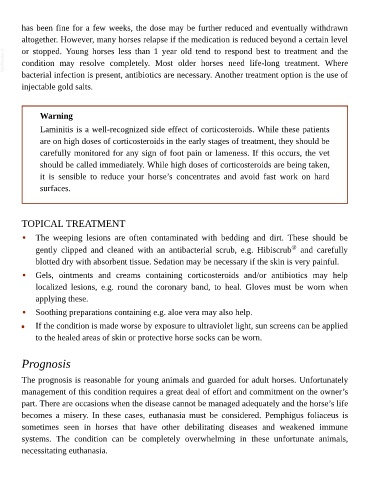Page 860 - The Veterinary Care of the Horse
P. 860
has been fine for a few weeks, the dose may be further reduced and eventually withdrawn
altogether. However, many horses relapse if the medication is reduced beyond a certain level
VetBooks.ir or stopped. Young horses less than 1 year old tend to respond best to treatment and the
condition may resolve completely. Most older horses need life-long treatment. Where
bacterial infection is present, antibiotics are necessary. Another treatment option is the use of
injectable gold salts.
Warning
Laminitis is a well-recognized side effect of corticosteroids. While these patients
are on high doses of corticosteroids in the early stages of treatment, they should be
carefully monitored for any sign of foot pain or lameness. If this occurs, the vet
should be called immediately. While high doses of corticosteroids are being taken,
it is sensible to reduce your horse’s concentrates and avoid fast work on hard
surfaces.
TOPICAL TREATMENT
• The weeping lesions are often contaminated with bedding and dirt. These should be
®
gently clipped and cleaned with an antibacterial scrub, e.g. Hibiscrub and carefully
blotted dry with absorbent tissue. Sedation may be necessary if the skin is very painful.
• Gels, ointments and creams containing corticosteroids and/or antibiotics may help
localized lesions, e.g. round the coronary band, to heal. Gloves must be worn when
applying these.
• Soothing preparations containing e.g. aloe vera may also help.
• If the condition is made worse by exposure to ultraviolet light, sun screens can be applied
to the healed areas of skin or protective horse socks can be worn.
Prognosis
The prognosis is reasonable for young animals and guarded for adult horses. Unfortunately
management of this condition requires a great deal of effort and commitment on the owner’s
part. There are occasions when the disease cannot be managed adequately and the horse’s life
becomes a misery. In these cases, euthanasia must be considered. Pemphigus foliaceus is
sometimes seen in horses that have other debilitating diseases and weakened immune
systems. The condition can be completely overwhelming in these unfortunate animals,
necessitating euthanasia.

